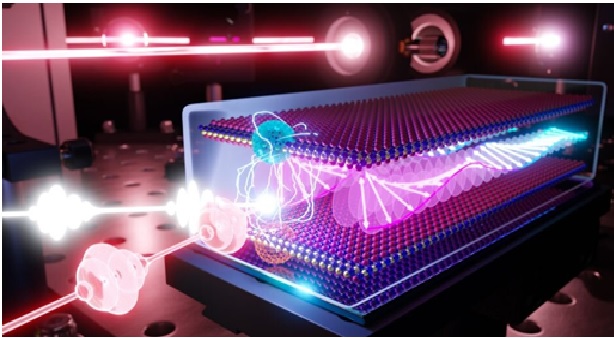Scientists see spins in a 2D magnet
All magnets -- from the simple souvenirs hanging on your refrigerator to the discs that give your computer memory to the powerful versions used in research labs -- contain spinning quasiparticles called magnons. The direction one magnon spins can influence that of its neighbor, which affects the spin of its neighbor, and so on, yielding what are known as spin waves. Information can potentially be transmitted via spin waves more efficiently than with electricity, and magnons can serve as "quantum interconnects" that "glue" quantum bits together into powerful computers. [1]

Figure 1. Scientists see spins in a 2D magnet
Figure 1 shows Magnons have enormous potential, but they are often difficult to detect without bulky pieces of lab equipment. Such setups are fine for conducting experiments, but not for developing devices, said Columbia researcher Xiaoyang Zhu, such as magnonic devices and so-called spintronics. Seeing magnons can be made much simpler, however, with the right material: a magnetic semiconductor called chromium sulfide bromide (CrSBr) that can be peeled into atom-thin, 2D layers, synthesized in Department of Chemistry professor Xavier Roy's lab. [2]
The results can be thought of as quantum transduction, or the conversion of one “quantum” of energy into another, said first author Yun Jun (Eunice) Bae, a postdoctoral fellow in Zhu’s lab. The energy of excitons is four orders of magnitude greater than that of magnons; now, because they pair so strongly, we can easily observe small changes in the magnons, Bae explained. This transduction may one day enable researchers to build quantum information networks that can take information from spin-based quantum bits – which normally have to be spaced millimeters apart – and convert it into light, a form of energy, which can transfer information for hundreds of miles via fiber optics. [3]
The work was supported by Columbia’s NSF-funded Materials Research Science and Engineering Center (MRSEC), with the material created in the DOE-funded Energy Frontier Research Center (EFRC). From here, the researchers plan to explore CrSBr’s quantum information potential, as well as other material candidates. “In the MRSEC and EFRC, we are exploring the quantum properties of several 2D materials that you can stack like papers to create all kinds of new physical phenomena,” Zhu said. [4]
References:
- https://www.sciencedaily.com/releases/2022/09/220907192611.htm
- https://phys.org/news/2022-09-scientists-2d-magnet.html
- https://escapefromwithin.com/scientists-see-spins-in-2d-magnet-sciencedaily/
- https://vervetimes.com/scientists-see-spins-in-a-2d-magnet-sciencedaily/
Cite this article:
Thanusri swetha J (2022), Scientists see spins in a 2D magnet, Anatechmaz, pp. 406

